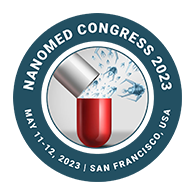Sessions and Tracks
TRACK 1: Nanotechnology
Nanotechnology contracts with materials and systems whose structures and components have advanced and significant features improved Physical, Chemical and Biological properties, processes and phenomena due to their Nano scale size.
It shows high proficiency in ending Cancer cells. Nano medicines also include Nano adjuvants with immune modulatory assets used to deliver vaccine antigens, Nano-knife, an almost non-invasive method of abolishing cancer cells with high voltage electricity and carbon nanotubes, which they already a popular way to repair smashed tissue and could be used to regenerate nerves in the future.
TRACK 2: Birth of Nanotechnology
The ideas and concepts behind Nano science and nanotechnology started with a talk entitled “there is plenty of room at the bottom” by physicist Richard Feynman at an American Physical Society meeting at the California Institute of Technology (Caltech) on December 29, 1959, long before the term nanotechnology was used. In his talk, Feynman described a process in which scientists would be able to manipulate and control individual atoms and molecules. Richard Feynman is considered the father of nanotechnology. The most important property that renders nanomaterials useful in a wide range of applications is the high surface-to-volume ratio. This one property alone has given the wide variety of applications of nanotechnology.
Applications:
The applications of nanotechnology widely range from industrial, medicinal, to energy uses. These include more durable construction materials, therapeutic drug delivery, and higher-density hydrogen fuel cells that are environmentally friendly.
Nanoparticles and Nano devices are highly versatile through modification of their physiochemical properties; hence they have found uses in Nano scale electronics, cancer treatments, vaccines, hydrogen fuel cells, and nanographene batteries.
Nanotechnology’s use of smaller-sized materials allows for the adjustment of molecules and substances at the Nano scale level, which can further enhance the mechanical properties of materials or grant access to less physically accessible areas of the body.
TRACK 3: Nano Drug Delivery System
A major topic of Nanomedicine research is drug delivery using nanoparticles and conjugates (Nano Drug Delivery Systems NDDs). The potential of nanoparticles to preferentially cross cell membranes and deliver drugs to target areas has sparked interest in this field. The recent discovery of multifunctional nanoparticles with multiple end-uses or properties (e.g., diagnosis and therapy with a single binding) has expanded the potential for translational Nanomedicine applications. Nanoparticle designs vary by delivery method. Oral drug delivery using Nano systems such as multi-component micro emulsions has been demonstrated for the delivery of drug-resistant anticancer therapies (drug conjugate uptake), and for psychotropic drug direct ingestion of drugs or drug Nano complexes in the oral cavity. (e.g., chewing gum).
TRACK 4: Nano metrices for Cell Culture
3D cell cultures mimic the length-scale of natural Nano scale methods and are currently being used to better understand how physical signals affect cell activity and coordinate cellular processes. Complex cells such as stem cell differentiation and tissue organization. Advances in nanotechnology have increased our ability to design stimulus-responsive interfaces that govern extracellular physical and biological signals as a function of location and time. Intracellular sensing and subcellular delivery were performed using synthetic, natural and cellular nanofiber substrates. The topic of nanotechnology cell-material interfaces is evolving rapidly, with the potential to revolutionize basic cellular research and regenerative medicine.
TRACK 5: Nanomaterials and Nanoparticles
Nano scale materials are substances that have at least one dimension that is not exactly about 100 nanometers. A nanometre is one millionth of a millimeter, or about one billionth of a millimeter, which is about one millionth the width of a human hair. Nanomaterials such as silver and gold nanoparticles are characterized by extraordinary optical, attractive, electrical and other properties revealed at this scale. These emerging trends could have a significant impact on hardware, healthcare, and other sectors. Creating small free groups and fusing them into bulk materials such as micelles/liposomes, or transplanting them into thick materials within liquids or strong lattices, most collected materials are Nano phases or bundles. This is how it is created.
TRACK 6: Nano device
Nano devices are incorporated into microcircuits or Nano circuits and provide for robust technologies. In the physics of Nano scale devices, the perfection of the evolution from microelectronics to Nano electronics was emphasized by the merging of quantum mechanical physics and the quasi classical electronic circuit theory. Nano devices are basically molecules with a purpose and have both simple and complex functions. Nano refers to characterization of parts measured in Nano-meters. Nano devices can be designed by computer software, such as MATLAB® and Nano explorer. Nano explorer works with collections of different hierarchical components, Nano systems, connections, molecular devices, and interfaces to develop Nano devices. There are two types of Nano device manufacturing processes: molding/etching materials to smaller components and Atom-by-atom assembly of structures. In the broadest sense, Nano devices allow researchers to exploit .The best examples of Nano devices are at present clearly associated with Internet of things (IOT) industries, where the potential for such devices is much broader due to the use of Nano battery systems that can extend the life span of an IOT device.
TRACK 7: Advanced Nanomaterials
Nanomedicine aims to provide a variety of useful research tools and therapeutically applicable devices. The pharmaceutical sector is working on new commercial applications of nanomaterials such as synthesis and self-assembly, improved drug delivery systems, new therapeutics, and nanoparticles for imaging and drug delivery. The study of toxicity and environmental impact of nanomaterials is another important and highly relevant area of research, as nanomedicine needs to be biocompatible for therapeutic applications.
TRACK 8: Micro and Nano Robots
The first generation of Small-Scale robots are generally referred to as "micro/Nano motors" or "micro/Nano engines" by researchers in the micro/nano robotics field, which are described as small scale devices capable of converting a variety of energy sources into locomotion or actuation. A micro/Nano robot, on the other hand, is a small scale device capable of mechanical actuation to fulfil a preprogramed task. It's been difficult to define what constitutes a micro/Nano robot because small-scale robotic designs differ significantly from their macroscale equivalents. When a new study subfield emerges from an established topic, its success is usually measured in terms of what it isn't rather than what it is. Automobiles, for example, were dubbed "horseless carriages" when they first appeared on the streets more than a century ago. When compared to internal combustion engines, electric motors, or hydraulic and pneumatic systems, the design of tiny size robots presents unique obstacles. Viscous forces dominate inertial forces at tiny scales. Environmental influences such as Brownian motion, which is induced by random collisions of water molecules with micro scale objects and interferes with the directionality of a motile micro/Nano robot, must be considered when designing structures at such a small scale.
TRACK 9: Carbon nanotechnology
Nanotechnology is no longer only a topic of conversation; it is beginning to have an impact on everyone's lives. Carbon nanotechnology has evolved into a fully interdisciplinary field that includes chemistry, physics, biology, medicine, materials science, and Engineering as a primary shaper of new nanotechnologies. This is a field in which a significant amount of literature has been produced in recent years, and the number of articles continues to rise year after year. Carbon Nanotechnology seeks to give timely coverage of latest developments in the field, as well as updated assessments and comments from internationally renowned specialists. Carbon Nanotechnology is intended to be an exhibition of cutting-edge research and development rather than a conference proceeding. It will be highly valuable not only to experienced scientists and engineers, but also to those who are new to the field. Who want to learn more about Nanotechnology and/or develop practical gadgets, as well as graduate and senior undergraduate students who want to make a name for them in this sector of the future?
TRACK 10: Nano Pharmaceuticals
Nano Pharmaceuticals have the potential to detect illnesses at an earlier stage, and diagnostic submissions could build on existing nanoparticle-based treatments. The term "Nano pharmaceuticals" refers to a new discipline in which the dimensions of a drug particle or a Therapeutic delivery system are measured at the Nano scale. The effort of getting the appropriate dose of a certain active drug to a specific illness site is a long-standing concern in the pharmaceutical industry. Traditional therapies, which advise site-specific targeting of active drugs, have failed to solve this deficiency. Nano pharmaceuticals have immense potential in overcoming this failure. Nano pharmaceuticals' precise targeting decreases hazardous systemic side effects, resulting in improved patient compliance. In today's global economy, the pharmaceutical sector is under tremendous pressure to provide high-quality yields to patients while being profitable. As a result, pharmaceutical companies are developing new drugs.
Drug target detection and drug delivery can be improved or supplemented with nanotechnology. Nano pharmaceuticals reduce drug discovery, design, and development costs while also improving medication delivery. As a result, the success rate of research and development improves, allowing for the introduction of innovative, cost-effective products to the market sooner.
TRACK 11: Nanotechnology Environmental Effects and Industrial Safety
As nanotechnology advances, so does the scope of its commercial application. Nanotechnology's vast advancement potential stems from the wide range of projected things and uses.The whole nanotechnology Sector is expected to generate US$ 75.8 billion by 2020, according to estimates. In such a situation, there is a massive open door for business people to tap into the fast growing business sector. Nano technological products, cycles, and Applications are expected to provide significant contributions to environmental and atmospheric security by conserving crude materials, energy, and water, as well as reducing ozone-depleting compounds and hazardous wastes. The use of Nanomaterials ensures certain natural benefits and implications on maintainability.
TRACK 12: Polymer Nanoparticles for Nanomedicine
Given that the majority of complex downstream symptoms of disease are caused by molecular level occurrences, using Nano scale materials and processes to treat human disease is probably the most promising. Nanomedicine is described as biological and medical intervention for the treatment, diagnosis, and better understanding of biology and illness at the Nano scale. Massive advancements in the field of polymer synthesis and self-assembly have led to the development of a new set of tailored Nano sized delivery and diagnostic agents that allow for local and systemic administration, bloodstream circulation, and cellular and subcellular uptake and diffusion.
TRACK 13: Nano therapeutics and Diagnosis
Nano therapy is a relatively new field that uses "nanotechnology" to diagnose and treat various diseases. In the next 510 years, nanotherapeutics could underpin the pharmaceutical and healthcare industries. Nanotechnology holds promise as a multifunctional platform for a variety of medical and technological applications, such as molecular sensors for disease diagnosis, therapeutic agents for disease treatment, and vehicles for delivering therapeutic agents and contrast agents for diagnostic purposes.
TRACK 14: Impact of Nanomedicine on Health Care
Nanotechnology's application in Human social insurance has the potential to improve treatment decision and treatment, as well as restore tissues and organs. It has the potential to totally transform the sector of human services in the future. Nanotechnology will aid medical Professionals in solving today's most significant treatment issues, such as restoring damaged organs, completing and treating diseased cells, removing obstructions in the brain, and improving medication delivery frameworks. Nanotechnology can be employed in biomedical research and applications both in vivo and in vitro. Nanoparticles can be utilised to target cancer cells in their early stages. Nanotechnology can be utilised to create "signature proteins" that can be used to cure cancer. Some of the linked societies include the American Chemical Society, Nanotechnology Security Resources, and the American Society of Precision Engineering (ASPE).
TRACK 15: Nanotechnology & Energy
The majority of research into hydride materials for imperativeness applications concentrates on revamping the materials' gravimetric limit thickness and molecule movement. On the other hand, the requirements for stationary applications, such as power devices, can be quite diverse and applicable to a broader range of potential materials. Different geophysical and socioeconomic pressures are forcing a shift away from fossil fuels and toward more sustainable and useful essentiality sources. We should create materials that will promote fresh imperativeness pushes to affect this shift. The most important requirement for making helpful and profitable photovoltaic cells is the presence of the sun. Catalysts for fuel cells are being made cheaper via nanotechnology. These catalysts generate hydrogen ions from methanol as a fuel. Nanotechnology is also a growing field. Membranes used in fuel cells to separate hydrogen ions from other gases, such as oxygen, are being employed to improve their efficiency.
TRACK 16: Future Concepts in Nanomedicine
Nanomedicine is said to be producing amazing results, including advances in cancer treatment. Imagine a world with many organ donors. Weak hearts are replaced so spinal cord injury victims can walk. This is the long-term outlook for regenerative medicine. It is a rapidly developing field. The development of creative new drugs has the potential to transform the treatment of human diseases. These treatments can speed recovery and complete recovery, but they increase the risk of side effects and problems faded.
TRACK 17: Computational studies in Nanoparticles
Computational studies on nanoparticles have shown significant progress in nanotechnology and biotechnology in recent years. However, some important challenges were also identified, including the need to better understand nanoparticle behaviour in vivo and the development of more effective nanoparticle therapeutics. Computing efforts are becoming an important tool for addressing both of these challenges and for facilitating and accelerating nanotechnology-based translational research in general. Nano informatics has emerged as a new research field involving the management of raw data, the analysis of data from biomedical applications, and the simulation of the interaction of nanoparticles with biological systems, and is widely used in biology, nanotechnology, and it represents integrating informatics to lay the foundation for computational nanomedicine.
Track 18: Design and Characterization of Nano drug systems
Recent years have seen the rapid development of inorganic nanomaterials for medical applications. Currently, nanomedicine - nanoparticles (NPs) intended for therapeutic or diagnostic purposes - can be found in a number of medical applications, including therapeutic and diagnostic agents. Pushing the boundaries of nanotechnology towards innovative nano therapies will certainly help reduce the side effects of traditional treatments and achieve an earlier diagnosis. The interactions between engineered nanomaterials and biological components are influenced by complex interactions that make predicting their fate and biological performance a challenge. We hope that both new and experienced researchers will find it useful in designing nanoparticles to enhance biological performance. Nano emulsions have received great interest in research, dosage design and drug therapy. This is the result of several properties that characterize nano emulsions.
Track 19: Nanotech: In other fields
Nanotechnology is a branch of technology that manipulates the molecular structure of materials to change their inherent properties and create new materials with ground-breaking applications. This is the case for Graphene, a modified carbon that is stiffer than steel, lighter than aluminium and almost transparent, and these nanoparticles are used in the electronics, energy, medical and defense sectors. Nanotechnology is a hot topic in research and development around the world, and nanomaterials are already present in hundreds of items, including sunscreens, cosmetics, fabrics and sports equipment. Drug delivery, biosensors and other therapeutic uses are all being developed using nanotechnology.
Market analysis
During the forecast period from 2022 to 2028, the nanomedicine market is projected to grow by 12.7%. The Data Bridge Market Research Report on the Nanomedicine Market offers analysis and insights into various factors that are expected to prevail during the forecast period and their impact on the growth of the market. Further development of nanotechnology for diagnostic procedures is driving the nanomedicine market.
In the latest study, Global Nanotechnology Market Outlook 2024, analysts conducted a segmentation study of the Nanotechnology industry and explained key market trends and developments, highlighting Clearly highlight areas that offer promising opportunities for industries to stimulate their growth.
Currently, the healthcare industry is one of the largest industries where nanotechnology has made a major breakthrough with its application in the diagnosis and treatment of chronic diseases such as cancer, cancer, and chronic diseases. heart, etc. In addition, important developments are taking place in other areas such as electronics, agriculture and energy. These topics will be covered in Nanomedicine Conferences 2023
Nanomedicine Market Country Level Analysis:
Countries covered in the Nanomedicine conferences Market report are North America USA, Canada, Mexico, Germany, France, UK, Netherlands, Switzerland, Belgium, Russia, Italy, Spain, Turkey, Rest of Europe, China, Japan, India, South Korea, Singapore, Malaysia, Australia, Thailand, Indonesia, Philippines, Rest of Asia Pacific (APAC) Asia Pacific (APAC), Saudi Arabia, United Arab Emirates, South Africa, Egypt, Israel in middle
North America dominates the nanomedicine market due to growing partnerships between companies operating in the region and nanomedicine start-up organizations. Additionally, increasing government support and R&D spending are expected to propel the nanomedicine market in the region throughout the forecast period. Due to increasing research grants, the Asia-Pacific region is expected to see significant growth in the nanomedicine market. Moreover, increasing venture capital investors from developing countries are expected to drive the growth of the nanomedicine market in the region in the coming years.















